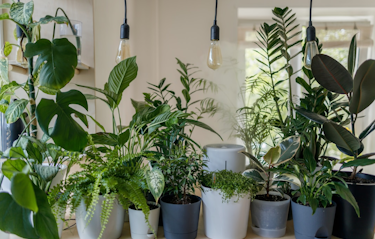
How To Trim Pothos
- Easy Care
- Araceae
- Large
- Evergreen Tropical Vines
We independently select everything we recommend. When you buy through our links, we may earn a commission.
A dying fiddle leaf fig plant can be caused by overwatering, underwatering, improper light (too much or too little), inadequate humidity, and pests.
Published on 22 August, 2023 by Oliver Rouane-Williams
A sick and dying fiddle leaf fig (Ficus lyrata) plant will have one or more of the following symptoms:
Brown spots or brown leaves
Curled leaves
Dropping leaves (leaf loss)
Holes in the leaves
Yellow leaves
Mottled leaves (from pests)
Wilted leaves
Excess water will flood the root system, cause root rot, and eventually kill a plant.
If the plant's leaves are yellow and drooping down or falling off, over-watering might be the problem. Does the soil look too wet or mushy?
Overwatering can also cause a fungal infection.
First, try adjusting your watering schedule. Let the plant dry out until the first two inches of the soil are dry.
If root rot or a fungal infection have set in, you may need to repot the plant. Be very careful because these plants do not handle transplanting well.
Gently remove the plant from the pot to check out the root ball. Use clean, sharp shears to prune off any damaged parts of the roots. When repotting, the pot you choose should have room for about four inches of fresh soil on the bottom. Choose a well-draining potting soil that includes peat-based and perlite and a container with drainage holes.
A fiddle leaf fig plant needs 5-6 hours of light daily.
They prefer bright, indirect light to thrive. This plant does well with some direct sunlight in the morning, but make sure it has some protection from the harsh afternoon sun.
Signs that your fiddle leaf houseplant needs more light include slow or leggy growth, dropping leaves, or growing toward a window to get more sunlight.
Place your plant where it will get the light it needs. Choose a window with direct morning sun and indirect sunlight for more of the day. South or west-facing windows are excellent spots for this plant.
Symptoms of not enough water include brown spots that start on the edge of the leaves, curling leaves, and dropping leaves. The soil may also be dry and hard and start pulling away from the pot's interior.
The first and most obvious solution is giving the plant water. Maintaining humidity in the room and regular misting can also help this plant thrive.
Adjust your watering schedule until the plant perks back up. Remember that in the warmer months during the growing season, almost all houseplants need more water.

Since fiddle leaf fig trees are tropical plants, they like humidity levels between 30-65%. Signs that your plant needs more moisture include cracked, shriveled, or torn leaves.
You can add a humidifier or pebble tray to a room to increase humidity or mist the plant regularly with a spray bottle. Grouping several plants together can also increase humidity through respiration.
The ficus lyrata can get a sunburn if it is getting too much light. The leaves will turn brown and crispy, and the soil will dry out faster.
Move indoor plants getting too much direct sunlight to a new location. Once a leaf is damaged by the sun, it cannot heal, so prune off those leaves using clean gardening shears or scissors.
Pests that can negatively impact your fiddle leaf tree plant include spider mites, mealybugs, and fungus gnats. You will see visible signs of pests once they appear.
Depending on the pest you are trying to remove, you may use insecticidal soap or neem oil to remove the pest from the leaves. You can also put a plastic bag around the pot and base of the plant, put it in the shower, and physically wash away certain pests, like aphids.
It depends on what your issue is. It’s a good idea to start by looking for obvious things, like a pest infestation. Then you can look at moving the plant’s location or changing its watering schedule to see what helps.
If there's no hope of saving your houseplant, see if it's healthy enough to take some stem cuttings for propagation.
Damaged leaves do not grow back and should be pruned so the plant doesn’t put any energy into them. However, any plant can experience new growth after pruning once it’s been nursed back to health.
When choosing a plant food for your fiddle leaf fig, a 3:1:2 is an excellent choice. That means three times the nitrogen as phosphorus in the mix and about twice as much potassium. This is the preferred mix for leafy houseplants.
Delivered to your inbox every Saturday morning








